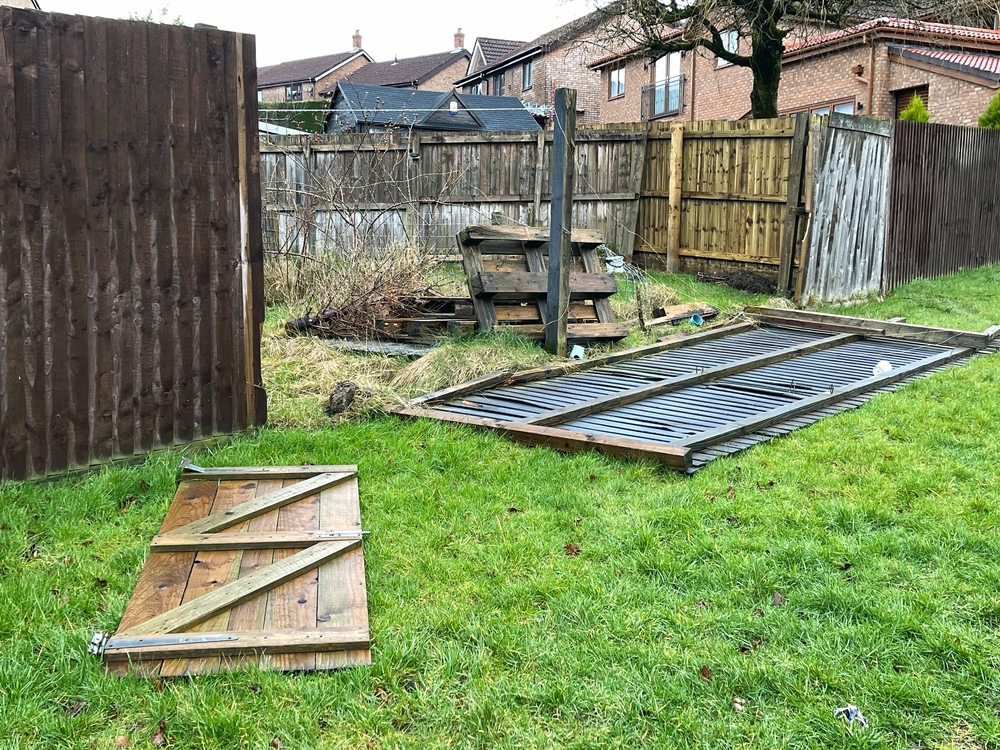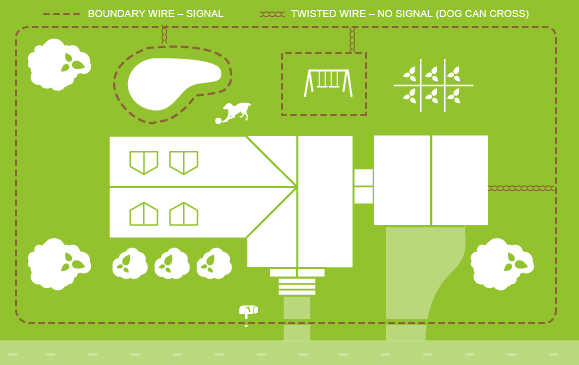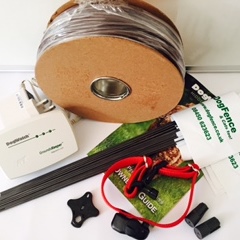How a Dog Fence Works – Safer Than Panels | DogFence UK
How Our Fence Systems Work (And Why It’s Safer Than Panels)
If you’re wondering how an electronic fence works and whether it’s a safer alternative to traditional panels or wooden fencing, you’re not alone. Many dog owners turn to invisible fencing after discovering that even tall garden fences can’t stop a determined escape artist. In this post, we’ll explain how electronic dog fences function, why they’re so effective, and how they protect both your pet and your property better than physical barriers. To see why so many owners choose this modern solution, read our guide on why traditional fencing isn’t enough for escape-artist dogs.

Traditional fencing fails—damaged panels like these can lead to costly repairs and escaping pets
What Is a Dog Fence—and How Does It Work?
A dog fence—sometimes called an invisible fence or hidden fence—is an electronic containment system that keeps your dog within a defined boundary using a radio signal rather than a physical barrier.
Here’s how a DogFence system works in practice:
- A wire is buried underground (or fixed above ground with pegs) to define the boundary
- This wire connects to a transmitter that emits a digital FM radio signal
- Your dog wears a lightweight receiver collar tuned to that signal
- As your dog approaches the boundary, the collar gives an audible warning beep
- If they continue forward, a mild static correction reinforces the boundary
- With simple training, dogs learn to stay well within their safe zone
Unlike GPS or AM-based systems, DogFence uses a digital FM signal for faster response time and fewer false corrections.
The diagram below shows a typical layout for a DogFence boundary wire. The wire can be buried underground or fixed above ground using pegs to create a secure containment zone. It can be customised to exclude flowerbeds, ponds, or driveways—giving your dog or cat full freedom while keeping them safely away from danger zones.

This layout shows how a DogFence boundary can be customised to protect key areas while giving pets freedom to roam
Why It’s Safer Than Traditional Fencing
Physical fencing might look secure, but many dogs learn to dig underneath, jump over, or chew through wooden panels. Some breeds even climb trellis or wire mesh. If your dog is a known escape artist, traditional fencing simply isn’t enough.
Here’s why electronic dog fencing is a safer, more effective option:
- No way to climb or dig under — boundaries are enforced via signal, not structure
- Built-in safety shutoff — the collar stops correcting after 15 seconds in the zone
- Customisable boundaries — protect flowerbeds, ponds, driveways, and more
- No risk of injury from jumping over panels or scraping paws on fence wires
- Long battery life and waterproof collars — ideal for active or outdoor dogs
We don’t just install a system and leave you to it. Our team provides full training so your dog quickly understands the boundary. Most pets learn within just a few days, and the vast majority rarely test the line after that.
Our systems include programmable settings to suit the size and temperament of your dog—from gentle for small breeds to stronger distractions for bold, high-prey-drive dogs.
Our expert trainers show you exactly how a dog fence works—giving your dog the guidance they need to stay safe and secure. Many owners make the switch for these 5 reasons to replace your garden fence with an invisible fence.
Choose DIY or Professional Installation
You can install one of our DIY kits starting from £299 or choose a professionally installed system with lifetime warranties and full on-site training. Either option offers a safe, stress-free way to keep your pet secure—without ruining your view or your garden.

Our DogFence DIY kit offers the same advanced technology as our pro systems—built for reliability, easy setup, and your dog’s safety.
Does a Dog Fence Hurt?
No — the mild static correction used in well-designed systems is completely harmless and designed to surprise, not punish your dog. According to DogWatch Inc, their electronic fences deliver a gentle static correction comparable to a mild static shock and are safe when used correctly. Training starts with an audible warning tone, and most dogs never receive a correction at all.
Each correction automatically shuts off after 15 seconds to ensure no overstimulation. With proper training, dogs learn the warning tones and avoid the boundary. Learn more about our training approach and safety protocols on our DogFence training page.
The correction is automatically cut off after just 15 seconds to prevent overstimulation. Combined with structured training, most dogs learn the boundary cues and rarely reach that zone.
Our DogFence DIY kit offers the same advanced technology as our pro systems—built for reliability, easy setup, and your dog’s safety.
How Does a Dog Fence Compare to Panels?
| FEATURE | DOGFENCE INVISIBLE FENCE | WOODEN OR PANEL FENCING |
|---|---|---|
| Climb/Dig Proof | ✅ Yes | ❌ No |
| Maintains Garden View | ✅ Yes | ❌ No |
| Custom “No-Go” Zones | ✅ Yes | ❌ No |
| One-Time Cost | ✅ From £299 | ❌ Often > £2,000 |
| Training Included | ✅ Yes | ❌ No |
Want to Learn More About How a Dog Fence Works?
If you’re tired of chasing your dog down the road or worrying about garden escapes, it’s time to consider an invisible fence. You’ll be joining thousands of happy owners who made the switch after traditional fencing failed them. Call us for more information and we can talk you through how a dog fence works and how it can work for you.
Related reading:
Call 01628 476475 or request a free quote to get expert advice.




